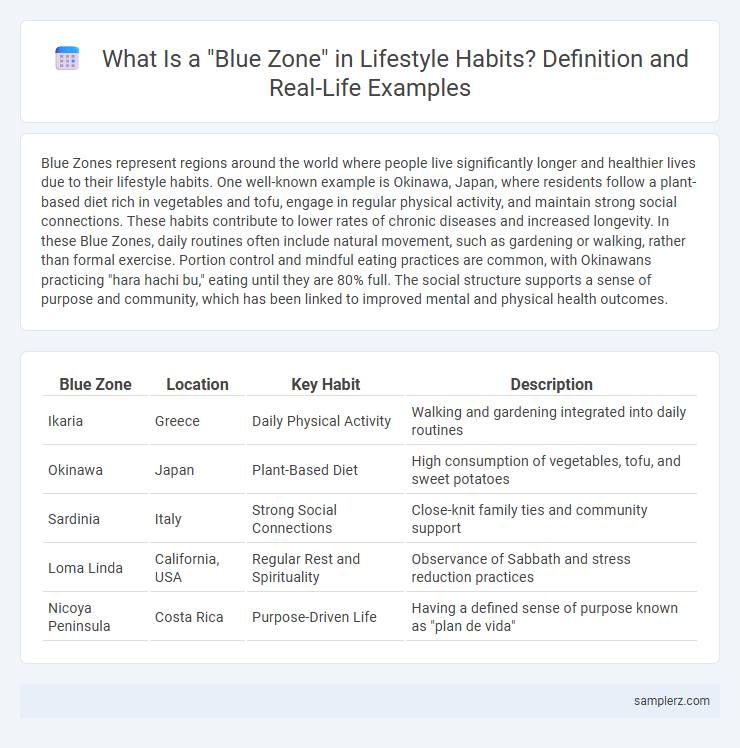Blue Zones represent regions around the world where people live significantly longer and healthier lives due to their lifestyle habits. One well-known example is Okinawa, Japan, where residents follow a plant-based diet rich in vegetables and tofu, engage in regular physical activity, and maintain strong social connections. These habits contribute to lower rates of chronic diseases and increased longevity. In these Blue Zones, daily routines often include natural movement, such as gardening or walking, rather than formal exercise. Portion control and mindful eating practices are common, with Okinawans practicing "hara hachi bu," eating until they are 80% full. The social structure supports a sense of purpose and community, which has been linked to improved mental and physical health outcomes.
Table of Comparison
| Blue Zone | Location | Key Habit | Description |
|---|---|---|---|
| Ikaria | Greece | Daily Physical Activity | Walking and gardening integrated into daily routines |
| Okinawa | Japan | Plant-Based Diet | High consumption of vegetables, tofu, and sweet potatoes |
| Sardinia | Italy | Strong Social Connections | Close-knit family ties and community support |
| Loma Linda | California, USA | Regular Rest and Spirituality | Observance of Sabbath and stress reduction practices |
| Nicoya Peninsula | Costa Rica | Purpose-Driven Life | Having a defined sense of purpose known as "plan de vida" |
Introduction to Blue Zones and Their Lifestyle Habits
Blue Zones, regions with the highest longevity rates such as Okinawa in Japan and Sardinia in Italy, exemplify lifestyle habits that promote health and lifespan. Common practices include plant-based diets rich in legumes, regular physical activity through natural movement like walking and gardening, and strong social connections that reduce stress. These habits collectively contribute to lower rates of chronic diseases and greater overall well-being.
Common Daily Routines in Blue Zone Communities
Residents of Blue Zone communities maintain consistent daily routines that promote longevity, such as walking to local markets, engaging in regular gardening, and prioritizing family meals rich in plant-based foods. These habits encourage physical activity, social connection, and balanced nutrition, which are foundational to the extended lifespans observed in regions like Okinawa, Sardinia, and Ikaria. Emphasizing movement through natural environments and shared meals helps support mental well-being and reduce chronic disease risks.
Nutrition Practices: What Blue Zone Residents Eat
Blue Zone residents prioritize plant-based diets rich in vegetables, legumes, whole grains, and nuts, while moderate consumption of fish and lean meats supports their longevity. Traditional meals emphasize natural, minimally processed foods with limited sugar and refined grains. These nutrition practices contribute to reduced inflammation, improved heart health, and sustained energy levels.
Physical Activity and Movement in Blue Zones
Residents of blue zones engage in natural, low-intensity physical activities like walking, gardening, and cycling, which contribute to their longevity and overall health. These habitual movements are integrated seamlessly into daily routines, avoiding strenuous workouts but ensuring consistent activity. This lifestyle promotes cardiovascular health, reduces chronic disease risk, and enhances mental well-being in blue zone populations.
Social Connections and Community Engagement
Blue Zone communities like Okinawa, Japan, exemplify the power of strong social connections and active community engagement in promoting longevity. Residents maintain lifelong friendships, participate in group activities, and support each other through cultural traditions that foster a sense of belonging. This social integration reduces stress, encourages healthy behaviors, and significantly contributes to overall well-being and extended lifespan.
Approaches to Stress Management in Blue Zones
Blue Zones like Okinawa, Japan, emphasize mindfulness practices and social engagement as key approaches to stress management. Residents often participate in meditation, prayer, or communal activities that foster a strong sense of purpose and belonging. This holistic approach to stress reduction contributes significantly to their longevity and overall well-being.
Purpose and Meaning: The Role of Ikigai
Ikigai, a cornerstone of blue zone communities like Okinawa, exemplifies the profound role of purpose and meaning in lifestyle longevity. This Japanese concept encourages aligning daily activities with personal passion, mission, vocation, and profession, fostering mental well-being and resilience. Research shows that individuals with a strong sense of ikigai often experience lower stress levels and enhanced life satisfaction, contributing significantly to their extended healthspan.
Sleep and Restful Living in Blue Zone Cultures
Blue zone cultures prioritize sleep by maintaining consistent bedtimes and incorporating afternoon naps, which improve overall health and longevity. Their restful living habits include creating calm sleep environments free from electronic distractions and embracing natural light cycles. These practices contribute to reduced stress levels and enhanced physical recovery, supporting a balanced, vibrant lifestyle.
Mindful Consumption: Moderation and Simplicity
In blue zones such as Okinawa, residents practice mindful consumption by embracing moderation and simplicity in their diets, often eating until they are 80% full, a habit known as "Hara Hachi Bu." Their plant-based meals emphasize whole foods, minimal processed ingredients, and moderate portions, supporting longevity and overall well-being. This lifestyle habit reduces chronic disease risk and promotes sustained energy throughout the day.
Adapting Blue Zone Habits to Modern Lifestyles
Adopting blue zone habits such as regular physical activity, plant-based diets, and strong social connections enhances longevity and well-being in modern lifestyles. Integrating daily walks, consuming nutrient-rich foods like legumes and vegetables, and prioritizing community engagement can significantly reduce stress and chronic disease risks. Emulating these proven practices fosters resilience and healthier living within fast-paced urban environments.

example of blue zone in habit Infographic
 samplerz.com
samplerz.com